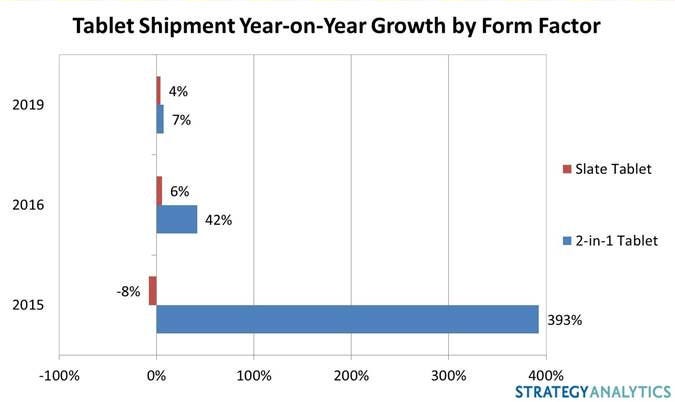Tablet market increasingly driven by 2-in-1 devices
New data from industry analysts Strategy Analytics reveals the stagnating tablet market is increasingly looking to Windows-based 2-in-1 devices for growth.
August 14, 2015

New data from industry analysts Strategy Analytics reveals the stagnating tablet market is increasingly looking to Windows-based 2-in-1 devices for growth.
While the overall tablet market is set to decline by 4% this year, SA reckons shipments of the 2-in-1 sub-category will increase by almost 400%, with the traditional PC channel exploiting Microsoft’s efforts to seed that market with its Surface devices. Windows 10 should make hybrid Windows tablets more user-friendly and, with Office likely to remain the default business productivity suite for the foreseeable future, the enterprise market should prove fruitful for this category.
“The timing could not be better for 2-in-1 tablets as Windows 10 makes the multi-mode computing experience smoother, Intel’s Skylake processors hit the market at the end of 2015, and Windows tablets have become more cost-competitive with Android tablets,” said SA’s Peter King. “Windows provides a familiar environment for traditional PC vendors to compete in the tablet market and also gives CIOs a higher level of comfort when considering higher-end tablets in the commercial setting.”
“Vendors have refined 2-in-1 tablet products in the last year to be affordable and functional and there is plenty of headroom for the segment to grow in the next five years as white box vendors seek to differentiate their low-cost products,” said SA’s Eric Smith. “The growth rate among 2-in-1 tablets will far outpace those of traditional slate tablets, though from a smaller base, as they compete for the spot of the secondary computing device in the home.”
SA is forecasting 2-in-1 shipment volume will increase from 11.5 million units this year to 22 million in 2019. It also forecasts around 23 million Windows tablets will be shipped this year, accounting for 10% of the total tablet market this year, which sizes it at around 230 million units.
An interesting feature of SA’s definitions is that Surface itself, which is the best-selling Windows tablet, is categorised as a slate, rather than 2-in-1, because the keyboard is an optional extra. If you move those Surfaces into the 2-in-1 category then it becomes even more important, especially when you consider that IDC’s Q2 2015 PC shipment data had that market declining by 12% to 66 million units.

About the Author
You May Also Like












_1.jpg?width=300&auto=webp&quality=80&disable=upscale)
